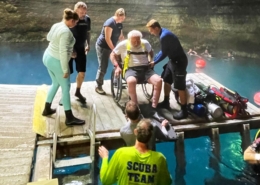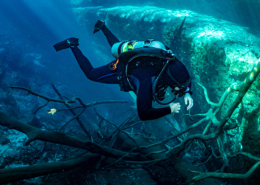Four meditation techniques for every scuba diver
By Margarita Solotskaya
Meditation is getting more and more popular in the western world. Many successful people use this method to help achieve their goals.
Meditation is often seen as one of the freediving preparation techniques. But – meditation and scuba? All this equipment, lead, heavy tanks and… lotus position? Weird idea, to say the least. Or not? How can meditation techniques be helpful for scuba divers?
1.Mindful preparation
Diving starts with preparation. Good planning, correctly assembled gear and a positive attitude are all elements of a comfortable dive. Some people don’t like preparation, but others (myself included) are fond of examining dive sites’ maps and planning the route, checking gasses and assembling equipment. So, what can we do to prepare better for the dive and make this step more enjoyable?
- Try to find something that will cheer you up in this process. Pay attention to it. You should take your time anyway, so why not have fun? Studying the dive site map, I try to imagine how this place will look underwater. During the dive I compare this mental picture with the real one. It’s interesting, both when they resemble each other and when they don’t.
- I like the process of preparing my equipment because it is well-thought out and logical. When everything is ready, I feel satisfaction because everything works well, is nicely arranged, and streamlined. If you don’t like your equipment, maybe it is time to make changes?
- Try to notice whether you are nervous. What, exactly, are you nervous about? Sometimes it is an unfinished report at work, but in this case, diving is the perfect way to distract from it and have some fun. However, at times I feel somewhat anxious before a dive without any special reason. If that happens, I mentally recheck all my equipment, to be sure that nothing was forgotten during preparation. That gives me confidence, but if some doubts persist, I know that there will also be a bubble check underwater. Usually this helps to alleviate any worries and leaves me just thrilled with the depths that await me. At the same time, it’s ok to feel some anxiety. It stops us from being careless and negligent. Water is a non-native environment for humans and we must dive well prepared.
- The last question that is worth asking is what exactly are you expecting from this dive? Sure, you have defined its purpose during planning, but now I’m talking about other things. You may want to have a calm underwater walk with a friend or your loved one, to experience weightlessness, to have a chance to spend some time alone or feel the total calm of the sea’s abyss, undisturbed by the waves passing on its surface. You can find your own purpose. By the way, if you have planned for a meeting with marine creatures, be sure to check that you’ve arranged it well. One of you might have the wrong time or place.
2. Seeing more
Diving is a contemplative sport. One of the most popular competitions among divers is “who sees more.” Have you ever won? Don’t cheat! Pay attention to what is already in front of you. You may notice something new, even in a familiar coral. During your dive, think about what in the unfolding landscape you have never actually seen before?
When I saw a tropical reef for the first time, I wanted to absorb it all at once. As a result, it all turned into a colorful spot inside my brain. My attention was skipping from one coral to another and I couldn’t concentrate on a single thing. Novice divers are usually attracted by bright large corals, schools of fish, huge pelagic creatures. They don’t notice small nudibranchs, shrimp, or worms that hide in their houses at the slightest movement. And then – a whole new world of tiny creatures opens to them!
Everything changes when you have hundreds of dives behind you. Everything is well-known and explored. But still, there is always possibility to look with more attention – this fish is unusually bright, that coral has such a lovely branch, and I have never seen it at this angle…
3. Be here and now
At my very first diving course in 2008, I quickly learned that I needed to fully concentrate on what I was doing; otherwise, I wouldn’t succeed. Before that, my whole life was marked by the “do two things simultaneously” slogan.
At that time, I was visiting Egypt with my 3 year old son was planning on spending my holidays at the beach. There was a diving center at our hotel, where I got acquainted with some divers. I wanted to see all the beauty of the sea that I loved so much. They told me that I could come on their boat with my child and somebody would take care of him while I was underwater.
The next morning, we were all ready and headed out to sea on a beautiful snow-white boat. Once onboard, I realized how much danger there were for a 3 year old – ladders, lines, heavy equipment, and finally the open dive deck! During my first dive, I was constantly thinking about my son – how is he, has he hurt himself, and is he bored? I don’t remember much of that dive, even though it was the renowned Red Sea. We were doing some exercises and I wasn’t very good at them (by the way, my son was absolutely fine).
I decided to take the course. While preparing to perform the hovering exercise – not an easy one for a beginner – I realized that if I continued to think about my son, I simply wouldn’t be able to do it. So, I concentrated only on what I was doing during the dive, because I was not near my son, not able to help him if… well, if what? He was fine. This dive is still in my memory. My hovering was irreproachable. I saw marvelous tropical reef fish of every color you can imagine. Afterward, my instructor told me that my eyes reflected my fascination with the underwater world. This dive was an immense pleasure and I still remember it eleven years later. That is not without reason. The feeling of happiness is directly linked to being in the present moment. Being able to think only about what we are doing and what is happening right now. I managed to accomplish this.
4. Breathing and getting relaxed
Usually, the first thing you are taught when learning meditation is to watch your own breath. In diving, breathing is practically the only thing that links us to the surface. Everything else is different – environment, vision, pressure, light, movement mechanics, etc. Pay attention to how you breathe. You should inhale and exhale slowly, calmly and deeply. This pattern ensures the most effective air consumption. Remember: never hold your breath. If you notice that your breathing pattern has altered, it may indicate that you are moving inefficiently.
Breathing and tension in your body are closely linked to one another. Tension makes us breathe more rapidly and use more air. It is important to relax during the dive, as it helps to feel more self-assured and spend less air. From time to time, pay attention to what is happening to your body and your breathing. This will help you to notice the first signs of excess tension in your legs or back. This may lead you to slightly change your body position, fin stroke or adjust your equipment before it becomes really uncomfortable.
Rapid shallow breathing is a sign of not only physical exertion, but of mental stress as well. If something underwater makes you nervous, you begin to breathe rapidly. The good news is that your breathing can help you to calm down too. Do you remember an old rule for diving emergency situations? “Stop. Breathe. Think. Act.” There is a reason for it. You should stop, not only to avoid worsening the situation, but also to concentrate on your breathing. By just paying attention to your breathing pattern, you will be able to calm down. But, if you do 2-3 conscious and deep inhalations and exhalations, anxiety will more than likely disappear and you will be able to analyze what made you nervous.
All these uncomplicated steps allow you to take a fresh look at diving and make each dive more enjoyable. After all, we all dive for the pleasure of being united with the wonderful underwater world!










Plaats een Reactie
Meepraten?Draag gerust bij!